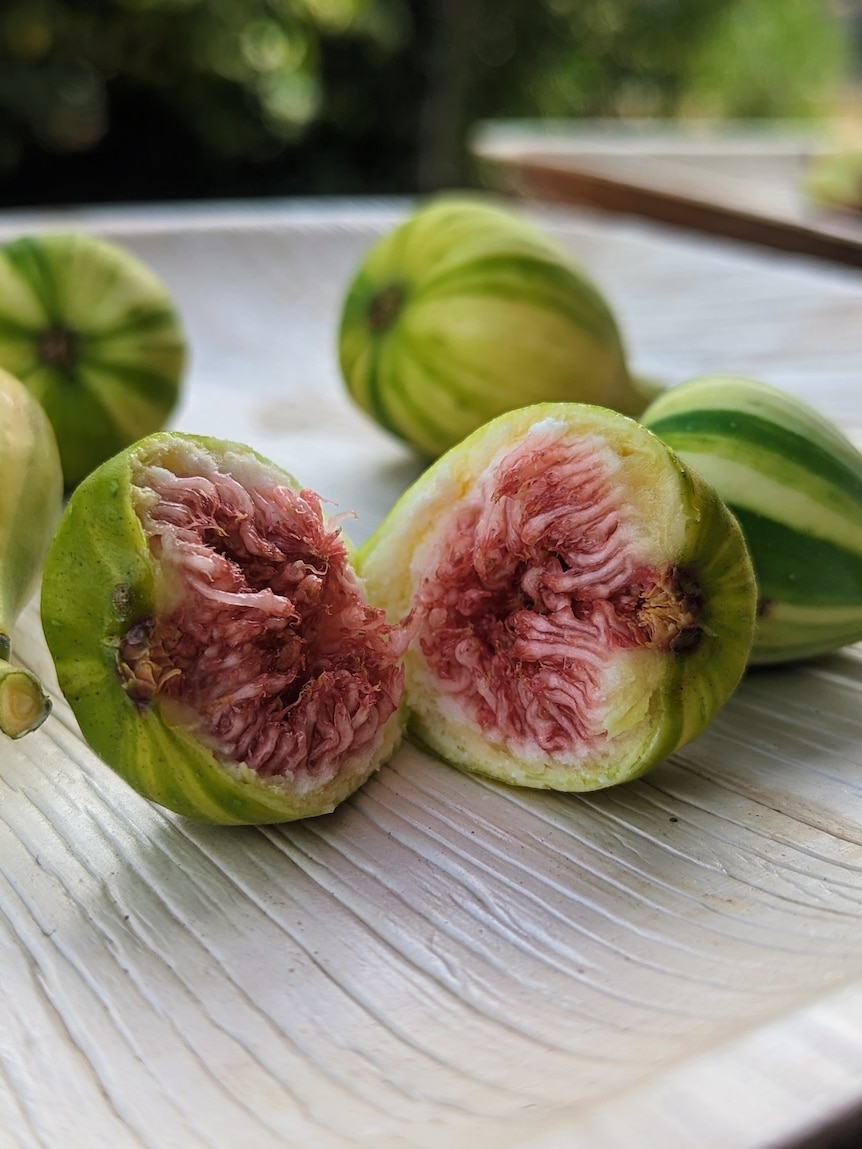Self-confessed “fruit collector” Ben Waddelow slices open a green and yellow striped fig to reveal a flesh that looks and tastes like a raspberry.
Fig season is his favourite time of year at his orchards at Sunlands in South Australia’s Riverland, about two hours north-east of Adelaide.
Mr Waddelow grows about 30 varieties of figs, with the panache or tiger fig one of the latest to be ready to sell to consumers.
“It’s got some commercial potential because it lasts a long time in the fridge, which some of our agents were very interested in,” he said.
“This is our first year of production but hopefully by our second and third years we will have a higher production so we can offer them in punnets to various vendors.”
His hand-picked fresh figs can go for as much as $60 per kilogram, but he expected the smaller stripy fig to sell for less.
Mr Waddelow said it had taken years of work to get to where he was, including sourcing the fig from a collector in Western Australia.
“I’m collecting unusual fruiting species … it’s an unusual addiction but I think it’s good,” he said.
Other varieties of figs in his orchards include the Tobruk fig, which is famous for its role in World War II.
“Australian soldiers hid in a cave during The Battle of Tobruk and at the front of it this fig tree was growing, and it protected them from the Luftwaffe [German army],” he said.
“They brought this tree back from Libya to Australia and it was grown in the Victorian war museum gardens.”
While some vegans may feel conflicted about eating the delicacy because of the fig wasp that crawls inside, Mr Waddelow said many varieties were actually self-pollinating.
“I’m a vegan and I still eat them but I have seen them [the fig wasp] and they are so tiny, they would almost fit on a pinhead,” he said.
‘Unusual’ fruit
Sydney food and travel writer Jane Lawson said she fell in love with figs about 30 years ago.
“It’s quite an unusual fruit,” she said.
“It almost looks frightening or prehistoric when you open it up because it has all these little seeds and this flesh, but when you bite into it the flavour is incomparable.”
The former chef said while she loved using figs in desserts, they also added a great edge to savoury dishes.
“It’s been quite warm recently so I’ve been putting them into salad,” Ms Lawson said.
“You only really see them when they’re in season so I’m a little bit guilty of throwing them into everything.”
More than one type
Ms Lawson said while there were thousands of varieties, most grocers only sold black genoa figs.
“Unfortunately what we see in the supermarkets is a fraction of what is actually available,” she said.
“If you have a farm gate nearby, go buy them directly.”
Murraylands resident Kerry Sonntag said she didn’t know what variety of fig grew on the big old trees she inherited at her property in Younghusband.
While she suspected they could be brown turkey, a robust purple-brown fig, she said she had plenty of demand selling them as a side hustle.
“It’s basically just local, word of mouth and people finding us online,” she said.
Ms Sonntag said her trees had two crops of fruit each year.
“We get a small amount in about November to December, and then about six weeks later we get a second lot, which will be a huge flush,” she said.
“Apparently the early figs are on the old [last season’s] wood but the later fruit is on the new wood of the tree and that’s why there is so much more fruit.”
Hot weather, strong supply
South Australian Produce Market marketing manager Penny Reidy said the hotter, drier weather had led to a good supply of figs and lower prices than usual.
“We have seen the supply increase significantly in the last couple of weeks, which has seen the price at the wholesale level reduced almost by half,” Ms Reidy said.
“But figs have always been a bit of a luxury item that never really go under about $20 a kilo.”
Ms Reidy said despite the cost-of-living crisis, the popularity of figs had not waned among consumers.
“People are still asking for them in the fruit and veg stores and they’re still buying them,” she said.
Key stories of the day for Australian primary producers, delivered each weekday afternoon.




